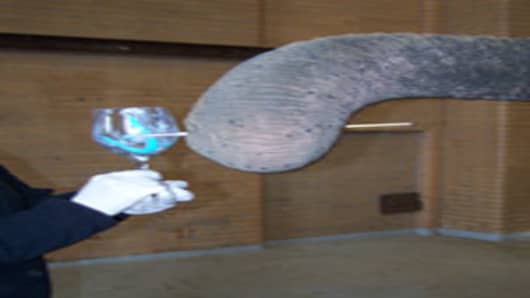You know the saying, “An elephant never forgets.” Well it’s true — elephants are supersmart and always looking for the next intellectual challenge.
At the Buffalo Zoo, the elephants do all kinds of things to keep busy — they play instruments, have scavenger hunts and even have watermelon-eating contests.
Surapa, a 28-year-old elephant the trainers describe as spunky and “a bit of a diva,” has discovered her hidden talent is painting. She paints year round, and her artwork is sold in the gift shop for $40.
She has two main styles, trainer Melissa King says — a circular swirl and what the zoo calls “blades of grass” — swipes up and down with the paintbrush. There can still be little curls on the end of the strokes, like the one in the picture below. Sometimes they wind up looking like things — like tulips or hearts — but mostly they’re abstract, King said.
If you had to liken her style to a famous painter, you might say it’s messy Matisse. But the big brush strokes also have a zen-like quality about them, much like the whole concept of a giant elephant holding a tiny paintbrush in her trunk. The zoo folks are not sure she has a favorite color, but when left to her own devices she seems to gravitate to yellow first.
In case you’re wondering, elephants are individuals, much like humans — not all of them paint. They used to have three elephants at the zoo (one died recently) and tried painting with each of the girls. One tried to eat the paintbrush, the other just stood there with the brush in her trunk. Only Surapa took to the canvas. Some of the other animals at the zoo — sea lions, monkeys, lizards, snakes and giraffes — make paintings occasionally for certain promotions, but it’s mostly running across a canvas with paint on it, slithering across it or, in the case of the giraffe, licking it! (Don’t worry, the paint is all non-toxic.)
This year, the zoo decided to have Surapa help them deck the halls — and bring in some extra revenue — by painting Christmas ornaments and wine glasses for the holidays. The wine glasses are sold in a pair, for $25, and the ornaments are priced at $10, $12 or $15, depending on the size.
She doesn’t paint every day — only if she’s in the mood. (Hey, you know artists, they can be moody!) The zoo said she probably paints several hundred items per year.
Here’s how it works: One of the trainers holds the glass or ornament and Surapa walks up, holding the paintbrush in her trunk, focuses carefully and delivers a few brush strokes to the item (She only does her “blades of grass” technique on these small items — they’re too small to do circles). The job pays pretty well — she is rewarded with small food items such as jellybeans, loaves of bread, whole cobs of corn and apples. The zoo gets to keep the revenue since, um, elephants don't have bank accounts (yet).
Of course, your first question — well, OK, your second question after “Seriously, an elephant who paints?” — is, “Doesn’t a gigantic elephant just crush a delicate ornament or wine glass?
“Actually, the only broken ornaments are from us keepers when we hang them up to dry!” King said. Surapa has never broken a single glass or ornament.
“With the smaller stuff like wine glasses and ornaments it requires a little more focus, a little more finesse,” King said. “Instead of using her elephant strength, she has to focus on the task at hand! And she really seems to enjoy it.”
Of course, like Santa’s elves, Surapa’s busier during the holiday season. She also is busy right before a special event, like the zoo’s “Elephantastic Weekend” in June, when Surapa and her older pal, Jothi, who's 30 and a little more laid back, show off all their mad elephant skillz like playing in an all-girl elephant band. Surapa plays the cymbal and rings a bell and Jothi plays the tambourine and harmonica.
In addition to expanding Surapa’s repertoire to include ornaments and wine glasses, some of the other money-raising programs the zoo has implemented since the recession are “Buy the Animals Lunch,” which raised about $1,200 to $1,500 a year, selling “Adopt-an-Animal” limited-edition ornaments, which has brought in $3,000 to $5,000 per year, and the “Tops Shop for the Animals” program, where they ask visitors to pick up something extra for the animals when they shop at Tops grocery store. That’s raised $1,500 to $2,000 a year. Some of the items on their grocery list are animal crackers (ha!), cereal, beef or chicken broth, bird seed, cranberry sauce, dried fruit, honey, jams and jellies, Kool-Aid, maple syrup and nuts.
Surapa even helped out with a wedding proposal once — the keepers painted “Will You Marry Me?” on the back of a painting and Surapa did the front. The guy gave the painting to his girlfriend and then flipped it over.
And yes, to answer your question — She said, "Yes!"
So, in some ways, you might say Surapa's other talent is matchmaker.
Now that’s getting the most out of your employees!
- Questions? Comments? Email ponyblog@cnbc.com or drop a line in the comment box below.
More from The Pony Blog: ponyblog.cnbc.com


.530x298.jpg?v=1366910946)

